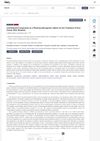TLDR 15d‐PGJ2 cream protects against UVB-induced skin damage in mice.
The study investigated the effects of topical administration of 15‐Deoxy‐Δ12,14‐prostaglandin J2 (15d‐PGJ2) using a nonionic cream on UVB-induced skin damage in hairless mice. UVB exposure led to various skin issues, including increased edema, enzyme activities, oxidative stress markers, and inflammation, while reducing antioxidant capabilities. The application of 15d‐PGJ2 in doses of 30, 90, and 300 ng/mouse effectively inhibited these pathological changes, demonstrating its potential as a therapeutic approach for protecting against UVB-induced skin oxidative and inflammatory damage. The unloaded cream showed no protective effects, highlighting the specific efficacy of 15d‐PGJ2.
 41 citations
,
July 2012 in “Stem Cells and Development”
41 citations
,
July 2012 in “Stem Cells and Development” Low-dose UVB light improves hair growth effects of certain stem cells by increasing reactive oxygen species.
 January 2025 in “Cellular & Molecular Biology Letters”
January 2025 in “Cellular & Molecular Biology Letters” Eicosanoids are crucial for skin health, and targeting their pathways may help treat skin conditions.
 3 citations
,
December 2022 in “Cells”
3 citations
,
December 2022 in “Cells” Cannabinoids like CBD and THC may help treat non-cancer skin diseases, but more research is needed.
 18 citations
,
October 2021 in “Frontiers in Physiology”
18 citations
,
October 2021 in “Frontiers in Physiology” Lipocalin-Type Prostaglandin D2 Synthase (L-PGDS) is a protein that plays many roles in the body, including sleep regulation, pain management, food intake, and protection against harmful substances. It also affects fat metabolism, glucose intolerance, cell maturation, and is involved in various diseases like diabetes, cancer, and arthritis. It can influence sex organ development and embryonic cell differentiation, and its levels can be used as a diagnostic marker for certain conditions.
October 2022 in “The Korean Journal of Physiology and Pharmacology” Targeting the PGD2-DP2 pathway may help treat hair loss.

New treatments for hair loss should target eight main causes and use specific plant compounds and peptides for better results.




